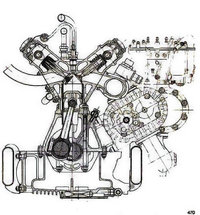Difference between revisions of "History of the Alfa Race Engine"
m |
m |
||
| Line 32: | Line 32: | ||
| − | '''[[ | + | '''[[Gioacchino Colombo]]''' |
Born in 1903, [[Colombo]] worked alongside Vittorio Jano for years before getting the chance to create one of his finest works, the 158 straight eight engine for Alfa in 1938. As the Germans dominated the existing [[Grand Prix]] formulas, it was time to try a different tact. Alfa Romeo would design a car which would dominate the voiturette class of 1500cc race cars. The birth of the 158 Alfa was a combination of the efforts of [[Enzo Ferrari]], [[Colombo]] and [[Liugi Bazzi]]. While successful right away, the 158/159 totally dominated Grand Prix racing in the post war era from 1946 to 1951, when Alfa retired from racing. | Born in 1903, [[Colombo]] worked alongside Vittorio Jano for years before getting the chance to create one of his finest works, the 158 straight eight engine for Alfa in 1938. As the Germans dominated the existing [[Grand Prix]] formulas, it was time to try a different tact. Alfa Romeo would design a car which would dominate the voiturette class of 1500cc race cars. The birth of the 158 Alfa was a combination of the efforts of [[Enzo Ferrari]], [[Colombo]] and [[Liugi Bazzi]]. While successful right away, the 158/159 totally dominated Grand Prix racing in the post war era from 1946 to 1951, when Alfa retired from racing. | ||
Revision as of 15:58, 2 February 2009
February 23rd 2005
Alfa Designers
Four of the Greatest
By Pete Vack
From the beginning, Alfa Romeo has been blessed with great designers. It is, after all, men who make the machines, and in the first half of the twentieth century, Italy produced a number of engineers who literally put this new and relatively poor country on the automotive map. Here are but four of the greatest engineers to have worked for Alfa Romeo, and who were responsible for the finest and fastest Alfa Romeos.
Chief engineer from 1910 to 1926, Merosi is generally remembered as the creator of the sturdy but not overly-exciting 24 hp, 20/30 series and RLs. However, in 1914, Merosi designed the first DOHC Alfa engine for the Grand Prix formula which stipulated a capacity of 4.5 liters. Merosi came up with a four cylinder, 16 valve head with valve angle of 90 degrees. The war halted its development, but in 1922 Merosi again produced a DOHC engine, a six cylinder, but it was to prove ineffective.
Giuseppe Merosi left Alfa in 1926, and worked as an engineer for a variety of other firms including Isotta Fraschini. He died in 1956 at the age of 84.
Perhaps the most gifted and prolific of all Alfa Romeo engineers, Vittorio Jano took over after Merosi left the company in 1926, having come from Fiat by the urging of Enzo Ferrari in 1924. He immediately began work on the P2 Grand Prix car, which was based on his experience with the very successful Fiat 805. The P2 was extremely successful, and was followed in rapid succession by the 6C1500, (1927) the 6C1750, (1929) the 8C2300 (1931) and what is perhaps his crowning achievement at Alfa, the 8C2900 in 1936.
Jano, in fact, almost single-handedly created the most successful Alfa Romeos, and along with that, the Ferrari-like legend that lives on today. Yet the failure of the 12 cylinder GP engine to defeat the Mercedes and Auto Unions in the late 1930s cost him his job at Alfa Romeo. Jano went on to Lancia, where again he engineered some of the greatest Lancia engines, among them the D-50 Grand Prix car in 1954. In 1965, fearing cancer, Vittorio Jano committed suicide.
Born in 1903, Colombo worked alongside Vittorio Jano for years before getting the chance to create one of his finest works, the 158 straight eight engine for Alfa in 1938. As the Germans dominated the existing Grand Prix formulas, it was time to try a different tact. Alfa Romeo would design a car which would dominate the voiturette class of 1500cc race cars. The birth of the 158 Alfa was a combination of the efforts of Enzo Ferrari, Colombo and Liugi Bazzi. While successful right away, the 158/159 totally dominated Grand Prix racing in the post war era from 1946 to 1951, when Alfa retired from racing.
After the war, Gioachino Colombo was asked by Enzo Ferrari to design a V-12 sports racing car. This he did in four months; the 125S became the first Ferrari and the progenitor of all the Ferrari V-12s. He died in 1987 after a long and illustrious career.
After WWII, a bombed out Alfa Romeo struggled to regain life. It was essential to begin the mass production of automobiles, but accord them the passion, handling, performance, and engineering principles which had made Alfa Romeo famous. This was accomplished by the team assembled by Chief Engineer Orazio Satta, which consisted of Gianpaolo Garcia, Giuseppe Busso, Ivo Colucci and Livio Nicolis. The team was responsible for the 1900 series, the 2600, 1300, 1600, 1750, 2000 and Montreal. For over 25 years, Satta guided his team to create the post war cars we have come to appreciate so much.
Born in 1910, Satta joined Alfa Romeo in 1939, appointed director of design and experimentation in 1951, and died in 1974 after a long illness.



